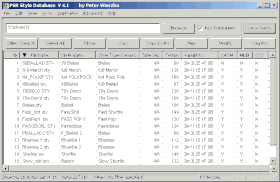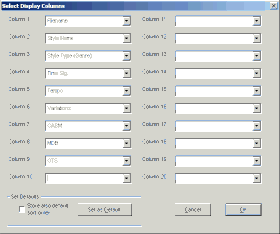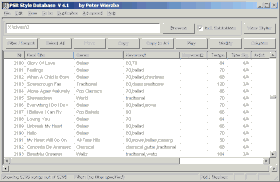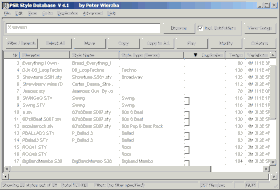Peter Wierzba, a software developer in the telecommunication industry and a Yamaha fan, developed the popular PSR Style and Midi Database, an essential tool for most Yamaha owners. The descriptions provided below, and the screens shots, are taken from Peter's site.
Peter also now maintains Michael Bedesem's Producer and MusicFinderView programs. You can download the latest version of both programs from Peter's Web Site.
Producer
Producer is a program originally written by Michael P. Bedesem. With the creation of Version 3.9.0 in 2016, Peter took over this project. Producer is a program for creating midi files based on keyboard styles. It is a powerful tool for creating or editing those so called Step Record files that only include the melody and special chord and style control commands. When Played or Expanded on YAMAHA keyboards, these files generate accompaniment parts. The link here will take you to Peter's web site where you can read more and download the program.
MusicFinderView, originally written by Michael P. Bedesem, is a PC editor for Music Finder (*.mfd) files. With it you can create, edit, display, rearrange, sort, and print Music Finder records. Music Finder files are keyboard specific, but with MusicFinderView you convert files from one instrument to another, for example, convert a Tyros mfd database for use on a PSR3000. The link here will take you to Peter's web site where you can read more and download the program.
PSR Style & Midi Database
The program is for managing collections of:
- style files (*.sty, *.bcs, *.pcs, *.prs, *.pst, *.sst) used for accompaniment on YAMAHA keyboards, and
- midi files (*.mid, *.kar) so it is also useful if you do not own such a keyboard.
The need for such a program arises if you have accumulated a large collection of style or midi files. Finding a particular style or midi file in such a collection can be a very time consuming task. Using this program, however, you can perform this task very quickly.
Main features
- Cataloguing of style and midi files.
- Searching for certain files according to various criteria.
- Very fast operation even with 50,000 or more files.
- Full automatic database handling.
- Allow users to store user-defined data.
- Allows manual cataloguing of the files.
- Files can be copied, moved, renamed.
- Data lists can be printed and exported.
- Can identify and filter duplicate style or midi files.
- Supports external player and editor programs for playing/manipulating the files.
Special feature for style files
Because of the huge number of available style files, manual cataloguing of styles is too great an effort (at least for one person or a small group). So this program utilizes an automatic "genre guessing" mechanism, which catalogues the style by examining the style file itself.
NOTE: The database program does NOT modify the style/midi files in any way.
Screen Shots
This is not a tutorial on how to use the PSR Style Database. However, the screen shots below and the associated comments will give you some ideas of how the PSR Style Database works and what you can use it for. Note that you can click on any screen shot for a larger view of that picture.
 Figure 1 is a screen shot of the PSR Style Database in
style mode. It shows major aspects of each style in the selected folder (and
subfolders). The view below includes the filename, style name, style type,
time signature, tempo, number of variations, whether the style CASM, a Music
Database list, or OTS.
Figure 1 is a screen shot of the PSR Style Database in
style mode. It shows major aspects of each style in the selected folder (and
subfolders). The view below includes the filename, style name, style type,
time signature, tempo, number of variations, whether the style CASM, a Music
Database list, or OTS.
Setting Columns
 You can, however, specify exactly which columns are displayed in the main
listing. By clicking the "Columns" button, the Select Display Columns
dialog box is opened. From here you can select how many columns to show and
what to put in each column. For example, clicking on the drop-down arrow
to the right of the Column 10 box will display a list of all the file attributes
available from which you can select an item to display in column 10. To remove
a column entry, simply highlight the entry in that column and delete it.
The items in the columns below that will all shift up one position.
You can, however, specify exactly which columns are displayed in the main
listing. By clicking the "Columns" button, the Select Display Columns
dialog box is opened. From here you can select how many columns to show and
what to put in each column. For example, clicking on the drop-down arrow
to the right of the Column 10 box will display a list of all the file attributes
available from which you can select an item to display in column 10. To remove
a column entry, simply highlight the entry in that column and delete it.
The items in the columns below that will all shift up one position.
Viewing Song Titles
 A style may be associated with one or more songs for which that style is
appropriate. When you add a record to the Music Finder Database, the song
title associated with the style is saved internally with the style. The PSR
Style Database will show you these song titles. If you click on the "View
Songs" button, you will open up the Song display screen (Figure 3).
Here is an example of where you would want to make sure that one of the columns
was displaying the relevant style name. If you were to copy that style over
to the User area of your PSR or Tyros keyboard, the song title(s) associated
with that style would automatically show up in your Music Finder database.
A style may be associated with one or more songs for which that style is
appropriate. When you add a record to the Music Finder Database, the song
title associated with the style is saved internally with the style. The PSR
Style Database will show you these song titles. If you click on the "View
Songs" button, you will open up the Song display screen (Figure 3).
Here is an example of where you would want to make sure that one of the columns
was displaying the relevant style name. If you were to copy that style over
to the User area of your PSR or Tyros keyboard, the song title(s) associated
with that style would automatically show up in your Music Finder database.
Finding Duplicate styles
If you have collected a large number of styles from the internet, there is a chance that some of those styles, which may have different file names, are actually the same style. I know this is hard to believe, but, yes, that can happen! Well, with Peter's PSR Style Database, it is a simple matter to identify your duplicate files. If you modify your column display to include a column for "Duplicates" and then sort on that column, the duplicate files are shown together.
 In Figure 4, all the styles in the X:\styles\ folder (and its subfolders)
are catalogued. The 8th and 9th styles, SWINGXG.STY and Swing.STY are identified
as duplicates. You see that the tempo matches and if you also viewed the
file size, you would see that these files also have identical file sizes.
Similarly, the 10th, 11th, and 12th files shown are all duplicates of each
other. Now that you can easily identify the duplicate files, you can select
the ones you want to eliminate and "Move" them to some other folder
you have created. This gets the files out of the original folder. You can
then, if you want, delete the styles that were moved. The PSR
Style Database will not directly delete any files itself. But it does
have a nice option to select all but one copy of each unique style. With
this you could move all the duplicates to some other folder in one fell swoop.
In Figure 4, all the styles in the X:\styles\ folder (and its subfolders)
are catalogued. The 8th and 9th styles, SWINGXG.STY and Swing.STY are identified
as duplicates. You see that the tempo matches and if you also viewed the
file size, you would see that these files also have identical file sizes.
Similarly, the 10th, 11th, and 12th files shown are all duplicates of each
other. Now that you can easily identify the duplicate files, you can select
the ones you want to eliminate and "Move" them to some other folder
you have created. This gets the files out of the original folder. You can
then, if you want, delete the styles that were moved. The PSR
Style Database will not directly delete any files itself. But it does
have a nice option to select all but one copy of each unique style. With
this you could move all the duplicates to some other folder in one fell swoop.
This page updated on February 15, 2024.
[top]